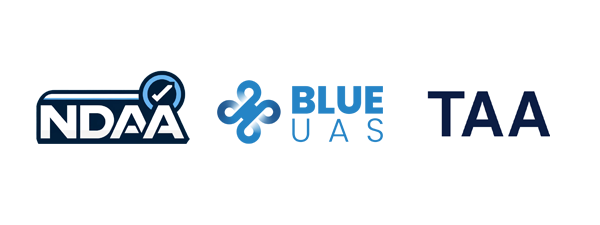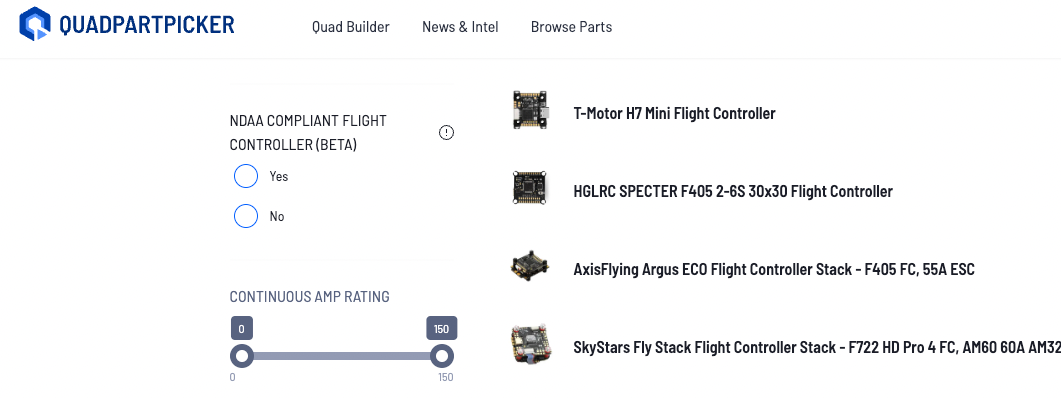American-Built: What NDAA, BlueUAS, and TAA Mean for Drones and Drone Design
Wondering what it means to build and design drones for the US government? We breakdown what it means to be NDAA, Blue UAS, and TAA-compliant

If you're designing and building drones to mass produce, this one is for you.
Why should I care?
The biggest drone news of 2024 is the federal legislative push to ban DJI drones in the United States under the Countering CCP Drones Act. The bill continues to be changed and amended, and is currently not law yet. However, the implications, if passed, are huge. As of 2021, DJI holds market share for 90% of the US hobby drone market, 70% of the industrial drone market, and 80% of the first-responder market.
More widely, as geopolitical tensions rise, uncertainty about what types of drones and drone parts can be procured and used in your country and/or organization also rises.
Given this landscape, there are several overlapping frameworks that continue to be updated. These frameworks give us an idea of what can go into a compliant American drone.
If you work for the US government, it's contractors, state and local law enforcement, you're already impacted as you have to continuously purchase and replace older fleets. And those who work with DJI drones in any capacity will be impacted next. This begs the question: what can you replace DJI drones with?
Currently, there are no 1:1 US-compliant drones that match DJI's product line in capability, price, and availability to purchase. This opens an opportunity for any drone designer and entrepreneur to fill the void in the sUAS space. Even if the government doesn't fully ban DJI drones, trends indicate that more drone options are needed just to keep current operations going. This doesn't even account for the wider adoption of drones for all sorts of use cases in coming years.
If you're just building drones for fun, this is still an interesting read on how drones might be designed and built in the near future.
What is NDAA Compliance?
The NDAA framework is derived from a law signed in 2019 called the National Defense Authorization Act for Fiscal Year 2020. It covers more than just drones, but for our purposes, we'll only get into what it means for drones and drone parts.
NDAA compliance mainly deals with where drone or drone parts come from and means two things:
- Drones are not manufactured or designed by a company based in a covered foreign country (China, Russian, Iran, and North Korea)
- Drones do not use flight controllers, radio, data transmission devices, cameras, gimbals, ground control systems, or operating software manufactured or designed by a company based in a covered foreign country (China, Russian, Iran, and North Korea)
The implication is: If your drone or drone parts are not NDAA-compliant, the United States Department of Defense (DoD) cannot procure and use them. This also applies to contractors that work for the DoD.
There is no certifying board or review process for NDAA compliance. If you're building a drone to be used by the federal government, you have to ensure and prove NDAA-compliance based on the two bullets above.
What is Blue UAS Cleared?
Blue UAS is a program created by the Department of Defense's Defense Innovation Unit (DIU). It evaluates drones, drone platforms, and parts for compliance including, but not limited to supply chain and cyber security compliance. All Blue UAS certified drones and components are also NDAA-compliant.
Drones that pass this certification are added to the Blue UAS Cleared List.
Drone parts, components, and software that pass this certification are added to the Blue UAS Framework.
It's worth noting that it takes a large investment to get Blue UAS cleared. In order to be considered to be on the Blue UAS Cleared List, you need a DoD sponsor organization that is able and willing to fund your platform to be continuously certified. In addition, what you build must offer a new capability or do something in a new way/method.
Because of this, you won't get Blue UAS clearance until you've found a potential government customer. If you're in the stages of building out a new capability, a fast track to ensuring compliance is to use components on the Blue UAS Framework.
Also note that given some of the requirements to be Blue UAS, a drone must not be connected to the internet (among other things). These rules will often be a barrier for manufacturers who want to sell their drones for both government and other commercial and enterprise purposes. Some companies make a variation just to be BlueUAS cleared while selling an NDAA-compliant version with more features for non-government uses.
One example of this is the Cube Blue flight controller which is essentially a Cube Orange, but modified to conform with NDAA, and certified for BlueUAS. Another example is the Skydio X10D drone which is essentially the same drone as their Skydio X10, but certified to BlueUAS specifications and specifically sold for military use.
Learn more from the Defense Innovation Unit.
What is TAA Compliance?
TAA stands for the United States Trade Agreements Act (TAA) of 1979. In short, TAA restricts the General Services Administration (GSA) from entering into certain procurement contracts if your drone or drone parts don't come from a TAA-compliant country. If your drone or drone parts are not TAA-compliant, it will make it difficult and/or impossible to sell to the US government.
By definition, a product is TAA-compliant if it is manufactured or substantially transformed in the United States, OR manufactured in a TAA-designed country.
We won't list the entire list of TAA-compliant countries. But it comes down to whether your drone or drone parts come from the United States, WTO Countries, Caribbean Basin Countries, Least Developed Countries, and Free Trade Agreement Countries.
Among the countries that export the most microelectronics for drones: China is not a TAA-compliant country. Japan and South Korea are TAA-compliant countries.
What are the Broader Industry Implications?
We're not here to debate whether its right or wrong to ban drones from a specific country or the benefits of on-shoring a nascent American drone industry. What's clear is that the government is taking the ban on DJI very seriously.
Legislators don't understand the wide implications of such a move. With most drone operators using DJI drones in their toolkit, if DJI is banned, the effects will be immediate. Infrastructure inspections will stop taking place, first responders will lose a critical tool, and small businesses focused on drone operations will be rendered useless.
While the US government leads the charge in banning DJI, many state and local governments have also enacted similar policies in the name of security. Whether substantiated or not, the current landscape is a patchwork of national, state, and local policies continue to change and confuse drone operators.
While many national, state, and local governments are using DJI drones today, the drone-operators using them just want products that will get their jobs done and be confident that what they use today will work tomorrow.
Regardless of the DJI ban and geopolitics, there's still a wide use case gap. This is an opportunity to engineer, design, and build small UAS to fill the needs of people who need them, and people who don't know they need them yet. Ultimately, starting your journey with compliant and off-the-shelf parts will make supply chain auditing much easier for you later.

QuadPartPicker recently updated to include parts that are NDAA-compliant, and soon, BlueUAS-cleared drone components.
